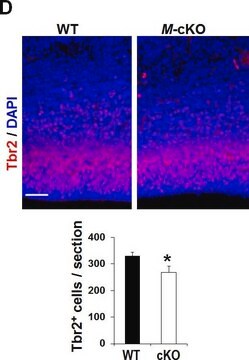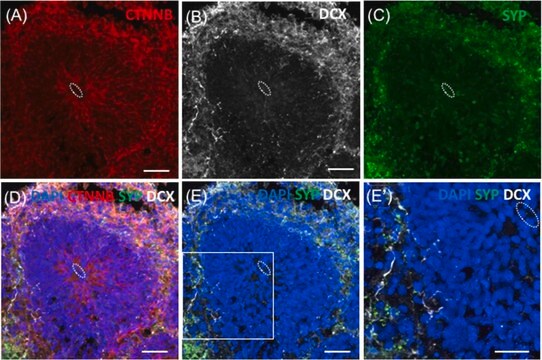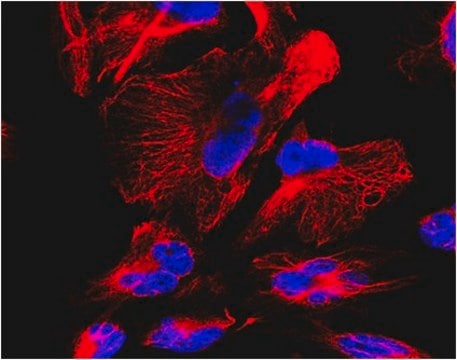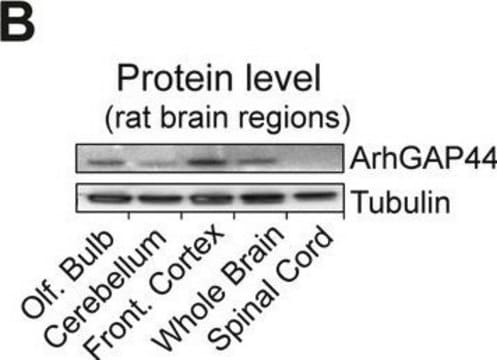MAB5326
Anti-Nestin Antibody, clone 10C2
clone 10C2, Chemicon®, from mouse
Synonym(s):
Anti-Nestin
Select a Size
Select a Size
About This Item
Recommended Products
biological source
mouse
Quality Level
antibody form
purified immunoglobulin
clone
10C2, monoclonal
species reactivity
human
should not react with
rat, mouse
packaging
antibody small pack of 25 μg
manufacturer/tradename
Chemicon®
technique(s)
immunocytochemistry: suitable
immunohistochemistry (formalin-fixed, paraffin-embedded sections): suitable
western blot: suitable
input
sample type epithelial cells
sample type neural stem cell(s)
General description
Specificity
Immunogen
application
WI-38 (ATCC# CCL75) can be used as a positive control. U251 cell line is also positive.
Immunocytochemistry: 1:200 on cells fixed in 4% paraformaldehyde and permeabilized with 0.02% Triton
Immunohistochemistry: paraformaldehyde is the preferred fixative: 1:200 on formalin fixed, paraffin embedded tissue sections. Use triton 0.02% in block only; dilution buffer 0.1% BSA; incubations 1-2 hours RT. Human fetal brain is suggested as a positive control. (CA Messam et al, Develop. Brain Res, 134:87-92, 2002; Gu, et al., Brain Res. 943:174-180, 2002). Filamentous staining in the cytoplasm of cells
Optimal working dilutions must be determined by end user.
Stem Cell Research
Neural Stem Cells
Target description
Linkage
Physical form
Storage and Stability
During shipment, small volumes of product will occasionally become entrapped in the seal of the product vial. For products with volumes of 200μL or less, we recommend gently tapping the vial on a hard surface or briefly centrifuging the vial in a tabletop centrifuge to dislodge any liquid in the container′s cap.
Analysis Note
Positive Control: WI-38 (ATCC# CCL75) or U251 cell lines
Other Notes
Legal Information
Disclaimer
Storage Class
12 - Non Combustible Liquids
wgk_germany
WGK 2
Certificates of Analysis (COA)
Search for Certificates of Analysis (COA) by entering the products Lot/Batch Number. Lot and Batch Numbers can be found on a product’s label following the words ‘Lot’ or ‘Batch’.
Already Own This Product?
Find documentation for the products that you have recently purchased in the Document Library.
Customers Also Viewed
Articles
ReNcell neural progenitors are immortalized human neural stem cell lines that can differentiate into neurons, astrocytes sand oligodendrocytes.
Fibroblast growth factors (FGFs) regulate developmental pathways and mesoderm/ectoderm patterning in early embryonic development.
Human iPSC neural differentiation media and protocols used to generate neural stem cells, neurons and glial cell types.
Protocols
A stem cell culture protocol to generate 3D NSC models of Alzheimer’s disease using ReNcell human neural stem cell lines.
Step-by-step culture protocols for neural stem cell culture including NSC isolation, expansion, differentiation and characterization.
Our team of scientists has experience in all areas of research including Life Science, Material Science, Chemical Synthesis, Chromatography, Analytical and many others.
Contact Technical Service















